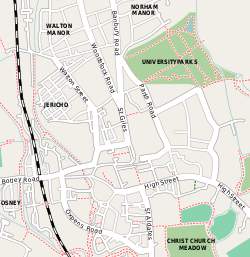- Museum of the History of Science, Oxford
-
Coordinates: 51°45′16″N 1°15′19″W / 51.75443°N 1.25519°W
Museum of the History of Science
The Old Ashmolean Building as it stands todayEstablished 1683 Location Broad Street, Oxford, England Type University museum of the history of science Director Jim Bennett Website www.mhs.ox.ac.uk The Museum of the History of Science, located in Broad Street, Oxford, is home to an unrivalled collection of scientific instruments from medieval times to the 17th century. Its collection of 18th and 19th-century instruments is also substantial. It is the world's oldest surviving purpose-built museum building.
Contents
Overview
The current collection contains around 18,000 objects from antiquity to the early 20th century, representing almost all aspects of the history of science and is used for both academic study and enjoyment by the visiting public. The museum contains a wide range of scientific instruments, such as quadrants, astrolabes (the most complete collection in the world with c.170 instruments), sundials, early mathematical instruments (used for calculating, astronomy, navigation, surveying and drawing), optical instruments (microscopes, telescopes and cameras), equipment associated with chemistry, natural philosophy and medicine, and a reference library regarding the history of scientific instruments that includes manuscripts, incunabula, prints and printed ephemera, and early photographic items.
Built in 1683 to house Elias Ashmole's collection, the museum building became known as the Old Ashmolean Building (to distinguish it from the newer Ashmolean Museum building where the Ashmolean Museum of Art & Archaeology moved in 1894) and was the world's first purpose-built museum building; it was also open to the public. The original concept of the museum was to institutionalize the new learning about nature that appeared in the 17th century and experiments concerning philosophy were undertaken in a chemical laboratory in the basement, while lectures and demonstration took place in the School of Natural History, on the middle floor. Ashmole's collection was expanded to include a broad range of activities associated with the history of natural knowledge and in 1924 the gift of Lewis Evans' collection allowed the museum further improvement, becoming the Museum of the History of Science and appointing Robert Gunther as its first curator.
The collection and the building itself now occupies a special position in the study of the history of science and in the development of western culture and collecting. One of the most iconic objects in the collection is a blackboard[1] that Albert Einstein used on 16 May 1931 during his lectures while visiting Oxford, rescued by E. J. Bowen at the end of the lecture.
From October 2009 through February 2010, the Museum hosted the first major exhibition of Steampunk art objects, curated by Art Donovan and presented by Dr. Jim Bennett, museum director.[2][3]
Admission is free and is open to the general public from noon until 5 p.m., Tuesday to Friday, from 10 a.m. until 5 p.m. on Saturdays, and from 2 p.m. until 5 p.m. on Sundays. (The museum closes for the Christmas and New Year period.)
Curators
The following have been Curator/Secretary to the Committee or director at the museum:[4][5]
- R. T. Gunther (1924–40)
- F. Sherwood Taylor (1940–45, temporary; 1945–50)
- C. H. Josten (1950–64; 1964–94, emeritus)
- F. R. Maddison (1964–94)
- J. A. Bennett (1994–present)
Gallery
-
Museum, Theatre and Printing House. Historical view east along Broad Street. Image courtesy of the Museum of the History of Science.
-
An early piece of radio equipment by Guglielmo Marconi, on display in the Museum
-
Stained glass window on the staircase at the museum, including Elias Ashmole's coat of arms
-
Blackboard used by Albert Einstein in a 1931 lecture in Oxford
See also
- Jim Bennett, the museum's Keeper
- Oxford University Scientific Society
- Whipple Museum of the History of Science, the equivalent institution at the University of Cambridge
References
- ^ Einstein blackboard, Museum of the History of Science, Oxford, UK.
- ^ "Steampunk". Museum of the History of Science, Oxford. http://www.mhs.ox.ac.uk/steampunk/. "Imagine the technology of today with the aesthetic of Victorian science. From redesigned practical items to fantastical contraptions, this exhibition showcases the work of eighteen Steampunk artists from across the globe."
- ^ Mark Ward (2009-11-30). "Tech Know: Fast forward to the past". bbc.co.uk. http://news.bbc.co.uk/2/hi/technology/8376028.stm. Retrieved 2009-11-30.
- ^ A. V. Simock (editor), Robert T. Gunther and the Old Ashmolean. Oxford: Museum of the History of Science, 1985. ISBN 0-903364-04-2. Page 93.
- ^ Robert Fox, The history of science, medicine and technology at Oxford, Notes & Records of the Royal Society, vol. 60, no. 1, pp. 69–83, 22 January 2006. doi:10.1098/rsnr.2005.0129
External links
Categories:- Buildings and structures completed in 1683
- Museums established in 1924
- Grade I listed buildings in Oxford
- History of museums
- Museums of the University of Oxford
- Science museums in the United Kingdom
- Grade I listed museum buildings
- History of science museums
- Ashmolean Museum
- 1924 establishments in England
Wikimedia Foundation. 2010.






